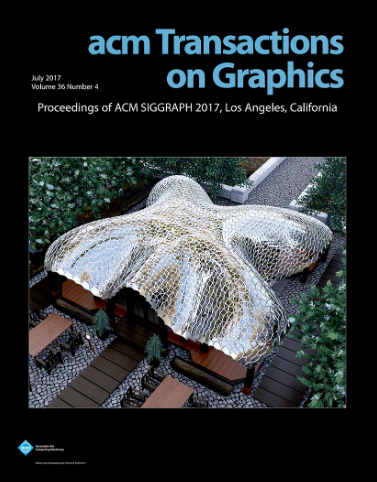GS-ROR 2:用于反射物体重光照和重建的双向引导3DGS和SDF
IF 9.5
1区 计算机科学
Q1 COMPUTER SCIENCE, SOFTWARE ENGINEERING
引用次数: 0
摘要
三维高斯飞溅(3DGS)以其精细的表达能力和高效的渲染速度显示出强大的新视图合成能力。不幸的是,使用3DGS创建可照明的3D资产和重建忠实的几何形状仍然存在问题,特别是对于反射对象,因为它的不连续表示增加了约束几何形状的困难。相反,体积符号距离场(SDF)方法提供了鲁棒的几何重建,但昂贵的射线推进阻碍了其实时应用并减慢了训练速度。此外,这些方法很难捕捉到尖锐的几何细节。为此,我们建议以互补的方式双向引导3DGS和SDF,包括SDF辅助的高斯溅射,用于有效优化重光照模型,gs引导的SDF增强,用于高质量的几何重建。我们的SDF辅助高斯喷溅的核心是混合高斯和SDF之间的深度和法线的相互监督,这避免了昂贵的SDF的体积渲染。由于这种相互监督,学习到的混合高斯函数以最小的时间成本得到了很好的约束。由于高斯分布是在延迟着色模式下渲染的,混合的高斯分布是平滑的,而单个高斯分布可能仍然是异常值,产生浮动伪影。因此,我们引入了一种SDF感知的剪枝策略来去除远离SDF定义的表面的高斯异常值,从而避免了浮子问题。这样,我们的GS框架提供了合理的法线并实现了逼真的重光照,而从深度融合的截断SDF (TSDF)网格仍然存在问题。因此,我们设计了一种gs引导的SDF细化方法,该方法利用高斯的混合正态来微调SDF。通过有效的增强,我们的方法可以以额外17%的训练时间为代价,进一步为反射物体提供高质量的网格。因此,我们的方法在重光照和网格质量方面优于现有的基于高斯的反向渲染方法。与基于nerf的方法相比,我们的方法也具有竞争力的重光照/网格质量,最多只需要25%/33%的训练时间,并允许在RTX4090上以每秒200帧的速度渲染。我们的代码可在https://github.com/NK-CS-ZZL/GS-ROR上获得。本文章由计算机程序翻译,如有差异,请以英文原文为准。
GS-ROR 2 : Bidirectional-guided 3DGS and SDF for Reflective Object Relighting and Reconstruction
3D Gaussian Splatting (3DGS) has shown a powerful capability for novel view synthesis due to its detailed expressive ability and highly efficient rendering speed. Unfortunately, creating relightable 3D assets and reconstructing faithful geometry with 3DGS is still problematic, particularly for reflective objects, as its discontinuous representation raises difficulties in constraining geometries. In contrary, volumetric signed distance field (SDF) methods provide robust geometry reconstruction, while the expensive ray marching hinders its real-time application and slows the training. Besides, these methods struggle to capture sharp geometric details. To this end, we propose to guide 3DGS and SDF bidirectionally in a complementary manner, including an SDF-aided Gaussian splatting for efficient optimization of the relighting model and a GS-guided SDF enhancement for high-quality geometry reconstruction. At the core of our SDF-aided Gaussian splatting is the mutual supervision of the depth and normal between blended Gaussians and SDF, which avoids the expensive volume rendering of SDF. Thanks to this mutual supervision, the learned blended Gaussians are well-constrained with a minimal time cost. As the Gaussians are rendered in a deferred shading mode, the alpha-blended Gaussians are smooth, while individual Gaussians may still be outliers, yielding floater artifacts. Therefore, we introduce an SDF-aware pruning strategy to remove Gaussian outliers located distant from the surface defined by SDF, avoiding the floater issue. This way, our GS framework provides reasonable normal and achieves realistic relighting, while the mesh of truncated SDF (TSDF) fusion from depth is still problematic. Therefore, we design a GS-guided SDF refinement, which utilizes the blended normal from Gaussians to finetune SDF. Equipped with the efficient enhancement, our method can further provide high-quality meshes for reflective objects at the cost of 17% extra training time. Consequently, our method outperforms the existing Gaussian-based inverse rendering methods in terms of relighting and mesh quality. Our method also exhibits competitive relighting/mesh quality compared to NeRF-based methods with at most 25%/33% of training time and allows rendering at 200+ frames per second on an RTX4090. Our code is available at https://github.com/NK-CS-ZZL/GS-ROR.
求助全文
通过发布文献求助,成功后即可免费获取论文全文。
去求助
来源期刊

ACM Transactions on Graphics
工程技术-计算机:软件工程
CiteScore
14.30
自引率
25.80%
发文量
193
审稿时长
12 months
期刊介绍:
ACM Transactions on Graphics (TOG) is a peer-reviewed scientific journal that aims to disseminate the latest findings of note in the field of computer graphics. It has been published since 1982 by the Association for Computing Machinery. Starting in 2003, all papers accepted for presentation at the annual SIGGRAPH conference are printed in a special summer issue of the journal.
 求助内容:
求助内容: 应助结果提醒方式:
应助结果提醒方式:


